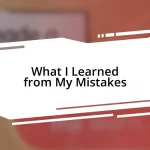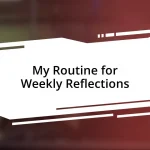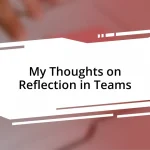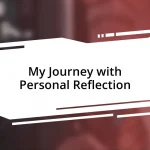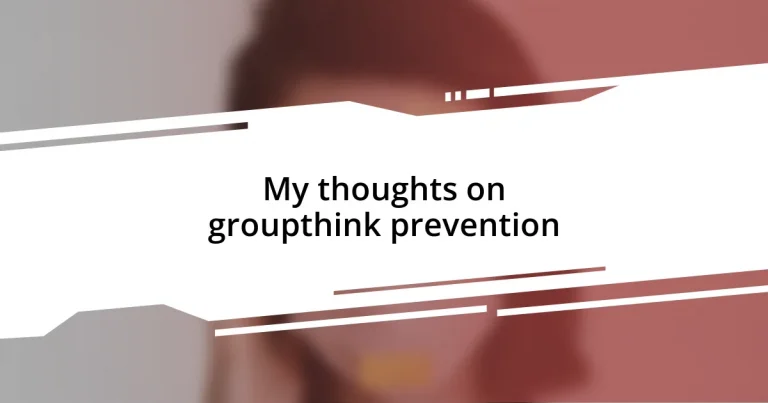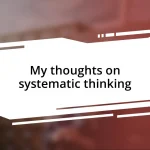Key takeaways:
- Groupthink occurs when the desire for harmony leads to irrational decisions, often manifesting in self-censorship and mind guarding.
- Key symptoms of groupthink include pressure on dissenters and an illusion of invulnerability, which can stifle creativity and critical thinking.
- Fostering open dialogue through ground rules, a “devil’s advocate” role, and anonymous feedback can prevent groupthink and enhance decision-making.
- Diverse team compositions and assessing decision-making processes are crucial for challenging assumptions and promoting innovative solutions.
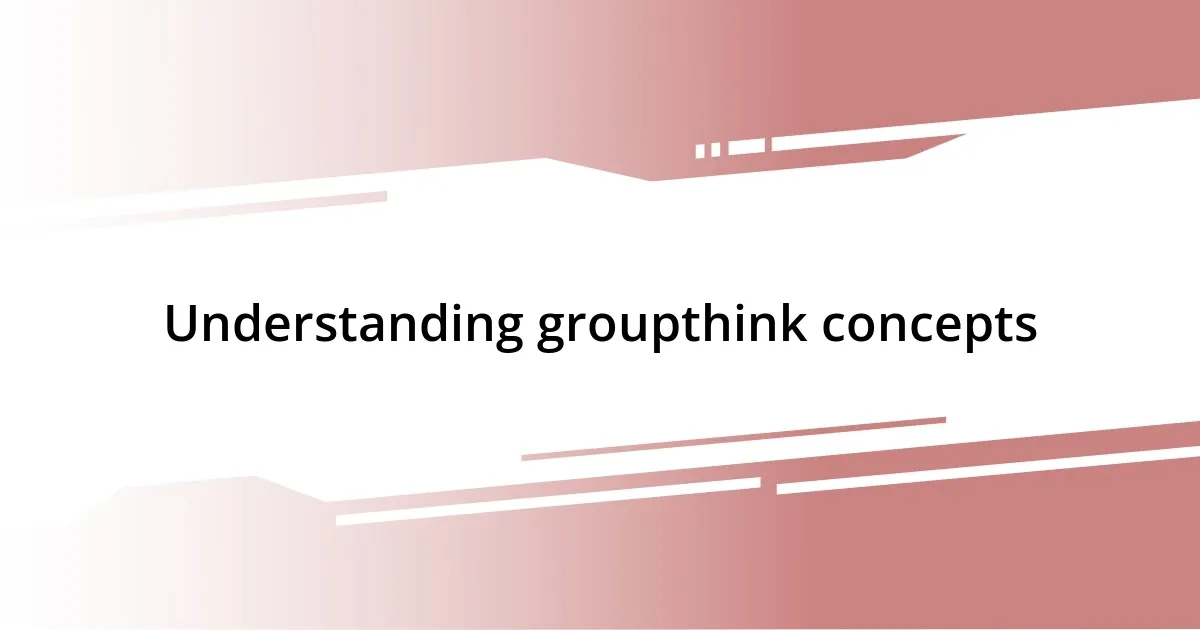
Understanding groupthink concepts
Groupthink, at its core, is a psychological phenomenon where the desire for harmony in a decision-making group leads to irrational or dysfunctional outcomes. I once found myself in a team meeting where we all nodded along to a flawed plan, blinded by a strong urge to keep the peace. Have you ever felt that pressure to conform, even when your instincts screamed otherwise?
This concept manifests in a few telltale signs, such as self-censorship and mind guarding, where individuals suppress their dissenting opinions to avoid disrupting the group’s cohesion. I remember a time when I held back my concerns about a project, thinking it would rock the boat, only to face greater consequences later when everything fell apart. It’s a stark reminder of how silence can overshadow individual insights, potentially causing real harm.
Ultimately, groupthink can stifle creativity and critical thinking. I often reflect on how diverse perspectives can elevate discussions and lead to better solutions. Engaging with differing viewpoints can feel uncomfortable, but isn’t that discomfort a small price to pay for innovation and clarity?
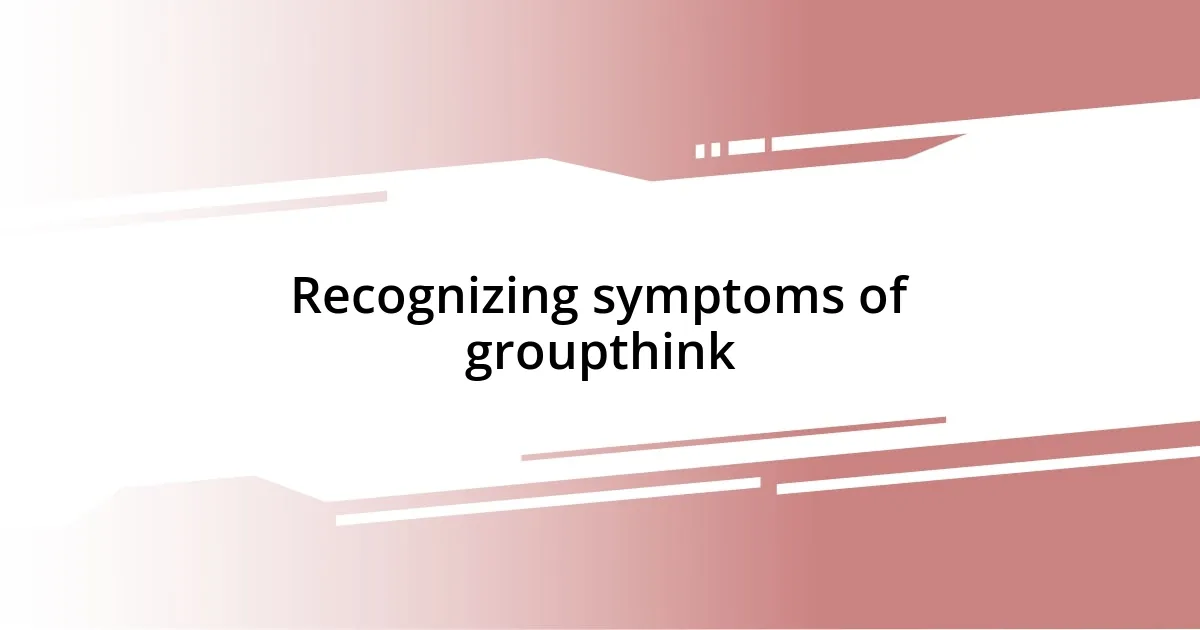
Recognizing symptoms of groupthink
Recognizing the symptoms of groupthink is crucial for fostering a healthier decision-making environment. I’ve encountered situations where a sudden silence in the room made me uneasy; it felt like everyone was holding back their thoughts. In these moments, I realized that just because everyone is nodding doesn’t mean they are in agreement. This silent compliance often hints at deeper issues within the group dynamic.
Some key symptoms to look out for include:
- Illusion of invulnerability: Team members feel overly confident in their decisions, dismissing potential risks.
- Collective rationalization: Groups justify their decisions, overlooking warnings or dissenting opinions.
- Self-censorship: Individuals refrain from expressing doubts or objections, fearing backlash.
- Pressure on dissenters: Those who do voice a contrary opinion might feel isolated or pressured to conform.
- Mind guarding: Certain members actively filter out or withhold information that contradicts the group’s consensus.
Reflecting on my experience, I’ve seen how these signals can transform a vibrant brainstorming session into a mere echo chamber. The fear of conflict can be stifling, and recognizing these patterns early can make all the difference in steering the group towards more thoughtful and inclusive discussions.
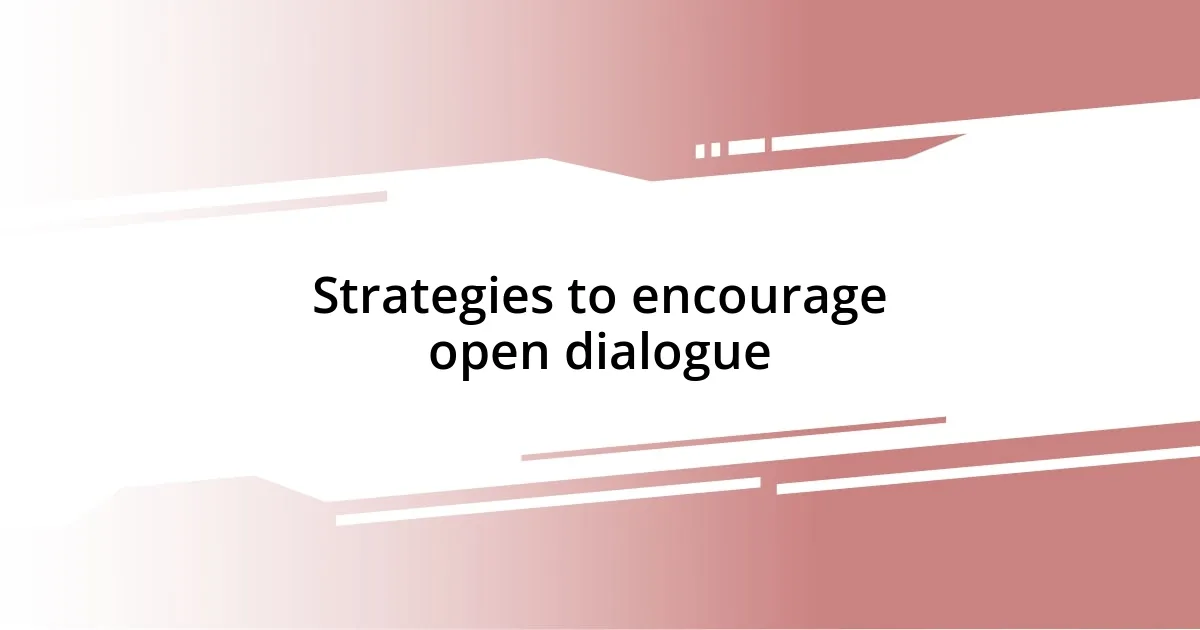
Strategies to encourage open dialogue
Creating an environment that encourages open dialogue is essential for preventing groupthink. In my own experience, I’ve found that establishing ground rules for communication can set the tone for a meeting. For example, when I implemented a rule that everyone must contribute at least one idea, it shifted the dynamics, making people feel respected and valued. Doesn’t it feel reassuring when you know your voice matters?
Another strategy is to actively invite feedback and questions. I remember a project where I designated “devil’s advocates” within our team. This role role gave certain members the responsibility to challenge ideas, which surprisingly led to more in-depth discussions. Encouraging healthy dissent may initially feel a bit uncomfortable, but often this discomfort opens the door to innovation — would you believe how many new insights emerged from those conversations?
Finally, utilizing anonymous feedback tools can further support open dialogue. In a recent project, we used an online platform where team members could voice their concerns without fear of judgment. I was amazed at how much sincerity and creativity flourished in such a safe space when individuals felt they could speak their minds freely.
| Strategy | Description |
|---|---|
| Ground Rules for Communication | Establish guidelines to ensure every team member contributes to discussions. |
| Devil’s Advocate Role | Designate team members to challenge ideas, promoting critical thinking and debate. |
| Anonymous Feedback Tools | Implement platforms for team members to share thoughts privately, reducing fear of retaliation. |
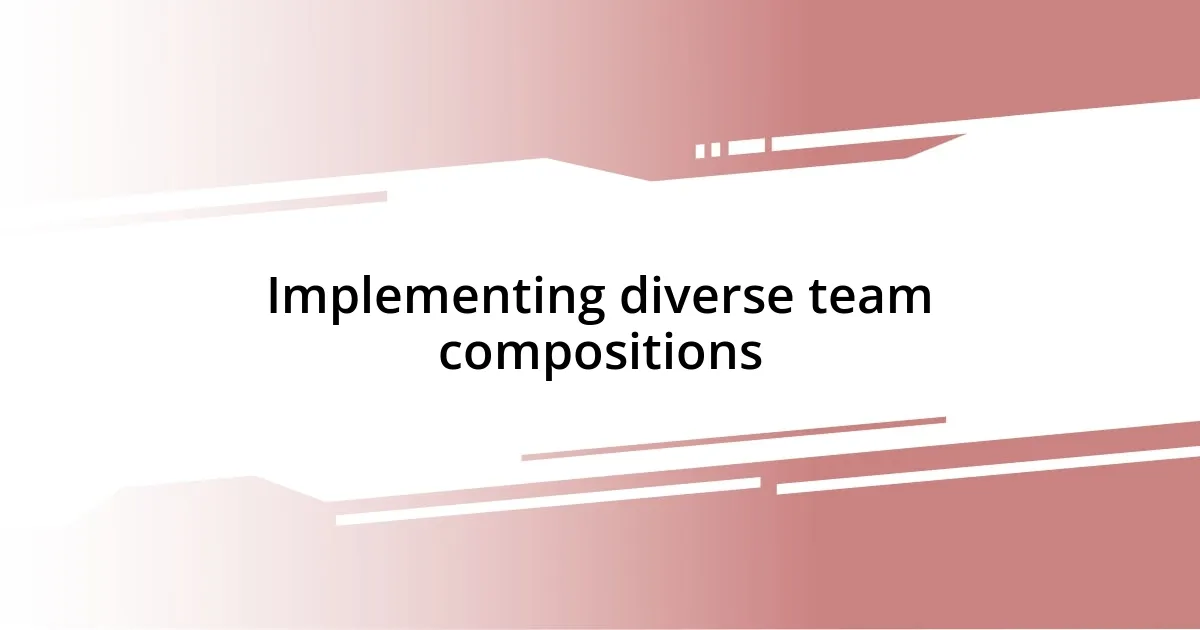
Implementing diverse team compositions
Diverse team compositions can significantly disrupt the typical patterns of groupthink. I recall a project where I collaborated with individuals from various cultural backgrounds and professional experiences. The conversations were richer and more engaging. It really opened my eyes to how diverse perspectives can challenge assumptions— have you ever noticed how a fresh viewpoint can illuminate ideas you hadn’t considered before?
In another instance, I worked with a team that included junior members alongside seasoned professionals. It was fascinating to see how the novices brought new energy and unfiltered questions to the table, prompting even the veterans to rethink their approaches. This blending of experience and fresh insight created an environment where assumptions were regularly questioned. It made me wonder: what hidden gems might we be overlooking if we only surround ourselves with like-minded individuals?
Furthermore, I have experienced firsthand the impact of incorporating team members from different disciplines. In one creative brainstorming session, the input from a tech-savvy designer completely shifted our direction, resulting in an innovative solution we hadn’t initially considered. It reinforced for me that when we intentionally foster diversity in our teams, we not only enhance creativity but also promote a culture where every voice feels empowered to contribute. Isn’t it exciting to think of what we could achieve when we embrace diverse perspectives?
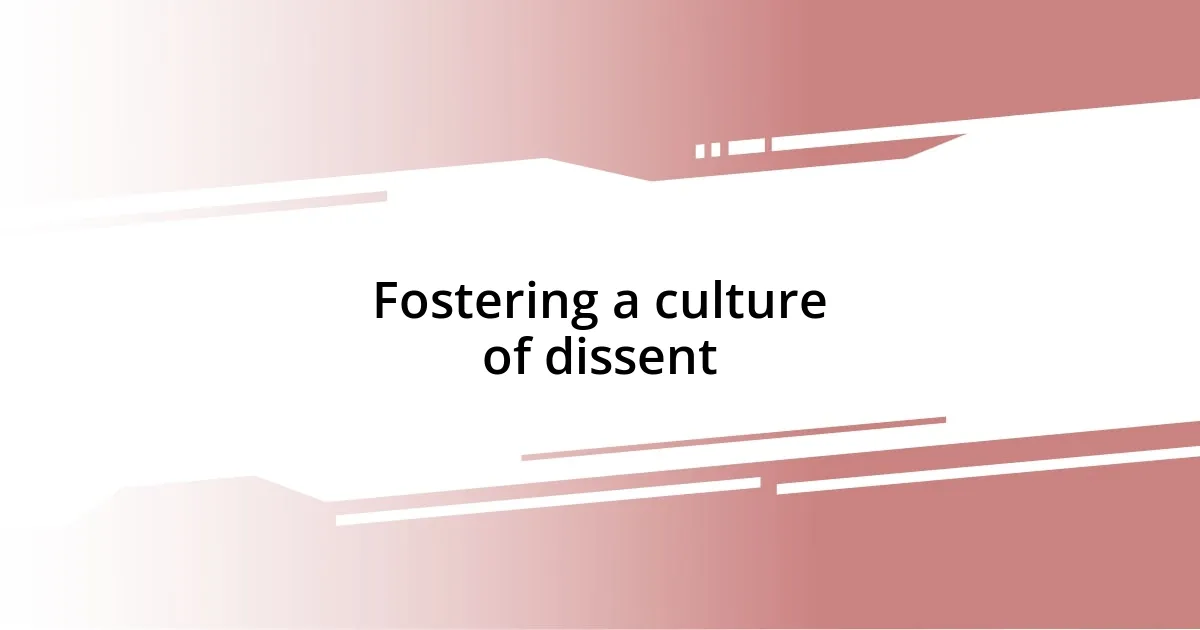
Fostering a culture of dissent
Fostering a culture of dissent requires a deliberate approach. I once facilitated a workshop where team members were encouraged to share their contrarian views on an ongoing project. The first few minutes were tense, but as individuals began to express their concerns, a sense of liberation filled the room. It made me realize that unleashing dissenting opinions can create a powerful shift in collective thinking—have you ever felt that thrill when a hidden concern finally surfaces?
In my experience, creating informal settings for discussions can make a world of difference. I’ve hosted casual lunch sessions where team members could voice their disagreements without the pressure of formal meetings. These gatherings not only humanized our interactions but also fostered deeper connections. Can you imagine how much more creativity can bloom in a relaxed atmosphere where every opinion is celebrated?
Sometimes, it’s about leading by example. I’ve openly shared my own doubts and hesitations during development phases, inviting others to do the same. When team members see that it’s okay to question strategies and share vulnerabilities, they often feel empowered to follow suit. There’s a certain magic that happens when you break the initial barrier of fear—what could we accomplish if we all felt safe to express our true thoughts?
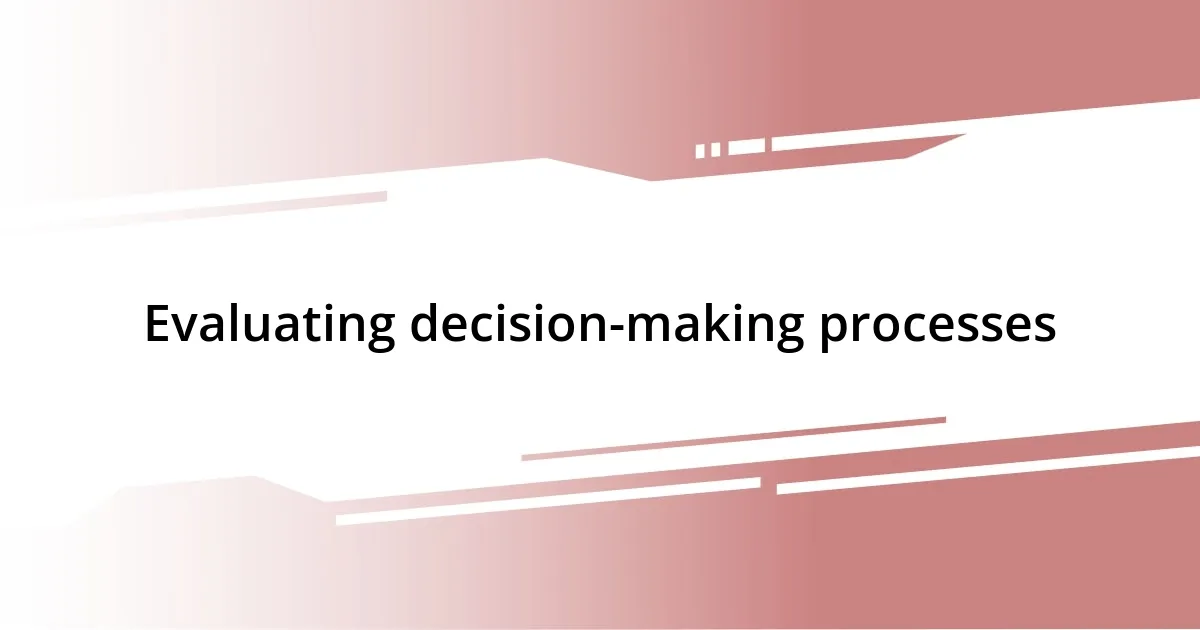
Evaluating decision-making processes
Evaluating decision-making processes is crucial for ensuring that groups don’t fall into the trap of groupthink. I remember a time when my team was at a crossroads, and we were facing a significant choice about which project to pursue. Instead of rushing into a decision, we took a step back and charted out the pros and cons of each option together. It struck me how this structured approach not only clarified our thoughts but also revealed hidden biases we hadn’t recognized. Have you ever paused to genuinely weigh your options?
In another situation, we implemented a decision matrix to evaluate potential projects based on various criteria like impact, resources, and feasibility. I found this method to be incredibly eye-opening. The transparent nature of scoring each idea helped us highlight discrepancies in our judgments, leading to more robust discussions. Wasn’t it refreshing to see how such a simple tool could enhance our overall decision-making quality and team confidence?
Moreover, seeking input from outside experts can also elevate the decision-making process. I once invited a mentor to review our proposed plan. Their outside perspective was invaluable—what seemed like an obvious choice to us turned out to be less favorable upon their analysis. It made me realize just how much we might be missing when we only rely on internal opinions. Isn’t it fascinating how an external viewpoint can challenge our convictions in the best possible way?
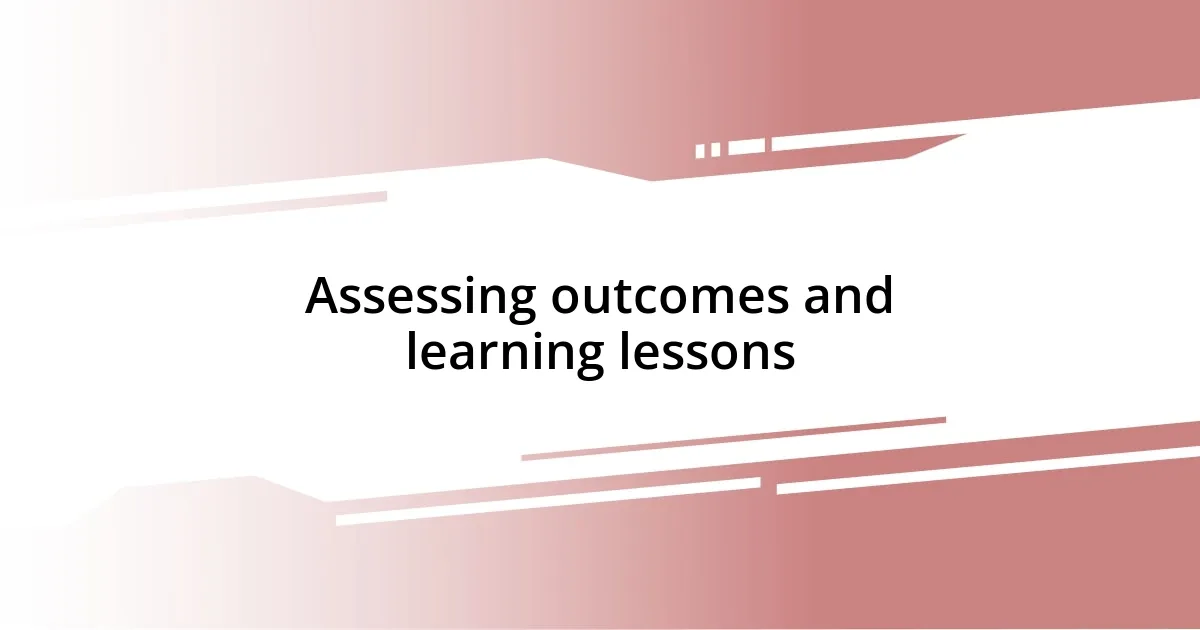
Assessing outcomes and learning lessons
One of the most enlightening experiences I’ve had in assessing outcomes was during a project debrief. We gathered to discuss what went well and what didn’t, and I encouraged everyone to speak honestly. One team member revealed how their earlier hesitations had been overlooked, causing us to miss an opportunity. That moment underscored the importance of seeking feedback: have you ever realized that a missed viewpoint could have changed everything?
As we dissected our project outcomes, I shared my belief that failures are just lessons wrapped in tough experiences. I recall a project that didn’t meet our targets, and instead of shying away from the discomfort, we embraced it. By analyzing where we faltered—not only in execution but also in communication—we unearthed valuable insights about our team’s dynamics. It was a cathartic moment; wouldn’t you agree that growth comes from facing our failures head-on?
It’s also essential to document these lessons learned. I’ve found that keeping a shared record of outcomes and reflections helps create a reference point for future projects. During a recent project, we noted all feedback and follow-up actions, which we then revisited months later. The realization that we had built a repository of knowledge not only made us more prepared but also fostered a culture where continuous improvement is valued. Have you ever considered how easy it is to forget critical insights without a proper system in place?




